
The Changbai Mountains are a major mountain range in East Asia that extends from the Northeast Chinese provinces of Heilongjiang, Jilin and Liaoning, across the China-North Korea border, to the North Korean provinces of Ryanggang and Chagang. They are also referred to as the Šanggiyan Mountains in the Manchu language, or the Great Paekdu in Korean. Most of its peaks exceed 2,000 m (6,600 ft) in height, with the tallest summit being Paektu Mountain at 2,744 m (9,003 ft), which contains the Heaven Lake, the highest volcanic crater lake in the world at an surface elevation of 2,189.1 m (7,182 ft). The protected area Longwanqun National Forest Park is located within the vicinity of the mountain range.

Paektu Mountain or Baekdu Mountain is an active stratovolcano on the Chinese–North Korean border. In China, it is known as Changbai Mountain. At 2,744 m (9,003 ft), it is the tallest mountain in North Korea and Northeast China and the tallest mountain of the Baekdu-daegan and Changbai mountain ranges. The highest peak, called Janggun Peak, belongs to North Korea. The mountain notably has a caldera that contains a large crater lake called Heaven Lake, and is also the source of the Songhua, Tumen, and Yalu rivers. Korean and Manchu people assign a mythical quality to the mountain and its lake, and consider the mountain to be their ancestral homeland.

The Tumen River, also known as the Tuman River or Duman River, is a 521-kilometre (324 mi) long river that serves as part of the boundary between China, North Korea (right) and Russia (left), rising on the slopes of Mount Paektu and flowing into the Sea of Japan. The river has a drainage basin of 33,800 km2 (13,100 sq mi).
Lake Tianchi Monster is the name given to what is said to be a lake monster that lives in Heaven Lake located in the peak of Baekdu Mountain within the Baekdu-daegan and Changbai mountain ranges encompassing Jilin Province of China and Ryanggang Province of North Korea. According to Beijing Youth Daily, an estimated 20 monsters were reported, however "scientists are skeptical that any large creature would be able to survive in the lake given its recent history of volcanic activity", and skeptics say "it's all in the imagination, or just a floating volcanic rock".
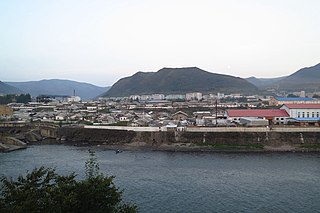
Hyesan is a city in the northern part of Ryanggang province of North Korea. It is a hub of river transportation as well as a product distribution centre. It is also the administrative centre of Ryanggang Province. As of 2008, the population of the city is 192,680.

Ryanggang Province is a province in North Korea. The province is bordered by China (Jilin) to the north, North Hamgyong to the east, South Hamgyong to the south, and Chagang to the west. Ryanggang was formed in 1954, when it was separated from South Hamgyŏng. The provincial capital is Hyesan. In South Korean usage, "Ryanggang" is spelled and pronounced as "Yanggang" Korean: 양강도; RR: Yanggang-do, Korean pronunciation:[jaŋ.ɡaŋ.do]).

Korea comprises the Korean Peninsula and 3,960 nearby islands. The peninsula is located in Northeast Asia, between China and Japan. To the northwest, the Amnok River separates Korea from China and to the northeast, the Duman River separates Korea from China and Russia. The Yellow Sea lies to the west, the East China Sea and Korea Strait to the south, and the Korean East Sea to the east. Notable islands include Jeju Island (Jejudo), Ulleung Island (Ulleungdo), and the Liancourt Rocks.

The emblem of North Korea is a national symbol adopted in 1993. Its design is modified from the former version in use from the founding of North Korea in 1948, which was introduced by painter Kim Ju-gyŏng. Prominent features on the emblem are a red star, a hydroelectric plant and Mount Paektu. The design bears similarities to the emblem of the Soviet Union and other emblems of the socialist heraldic style.
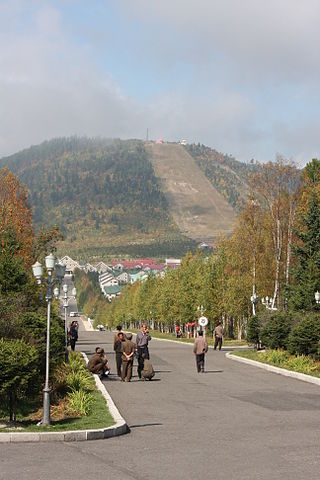
Samjiyŏn is a city in Ryanggang Province, North Korea. It takes its name from three lakes in the city, which are collectively known as the Samjiyŏn. Samjiyŏn is situated near Mount Paektu, and tour groups fly to the city's airport to see the mountain, which holds significance in North Korean mythology. Samjiyon is the least populated city in North Korea

The Grand Mass Gymnastics and Artistic Performance Arirang, also known as the Arirang Mass Games, or the Arirang Festival is a mass gymnastics and artistic festival held in the Rungrado May Day Stadium in Pyongyang, North Korea. The games usually take place in August or September. The Arirang Mass Games were held annually between 2002 and 2013, with the exception of 2006. After a five-year hiatus, Mass Games returned for a performance entitled 'The Glorious Country' in 2018.
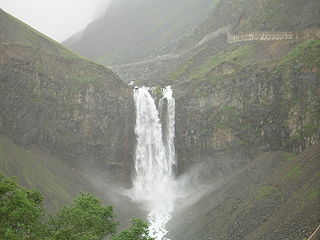
Changbai Waterfall is a 68 m (223 ft)-tall alpine waterfall in Northeast China, located to the north slope of the Changbai Mountain, the tallest summit of the Changbai Mountain Range between China and North Korea.

The Kumsusan Palace of the Sun, formerly the Kumsusan Memorial Palace (금수산기념궁전), is a building near the northeast corner of the city of Pyongyang that serves as the mausoleum for Kim Il Sung, the founder of North Korea, and for his son Kim Jong Il, both posthumously designated as the Eternal leaders of North Korea.

Kwangmyŏngsŏng-1 or Gwangmyeongseong-1 was a satellite allegedly launched by North Korea on 31 August 1998. While the North Korean government claimed that the launch was successful, no objects were ever tracked in orbit from the launch, and outside North Korea it is considered to have been a failure. It was the first satellite to be launched as part of the Kwangmyŏngsŏng program, and the first satellite that North Korea attempted to launch.

The Mansu Hill Grand Monument is a complex of monuments in Pyongyang, North Korea. There are 229 figures in all, commemorating the history of the revolutionary struggle of the Korean people, and especially their leaders. The central part of the monument consists of two 22-meter-tall (72 ft) bronze statues of Kim Il Sung and Kim Jong Il.
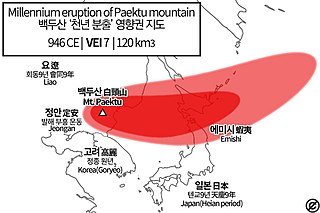
Paektu Mountain, also known as Changbaishan, on the border of the Democratic People's Republic of Korea and China erupted in late 946 CE. This event is known as the Millennium Eruption or Tianchi eruption. It is one of the most powerful volcanic eruptions in recorded history and is classified as a Magnitude 6.5-7 eruption.
"We Will Go to Mount Paektu" is a 2015 North Korean light music song in praise of the country's leader, Kim Jong Un.

Jong Il Peak is one of the peaks of Mount Sobaek, south-east of Paektu Mountain. The height is 5,899 ft (1,798 m). It is located near the shore of Sobaek Stream, in Samjiyon County, Ryanggang Province, North Korea.
The September 2018 inter-Korean summit was the third and final inter-Korean summit in the 2018-19 Korean peace process.

A volcanic crater lake is a lake in a crater that was formed by explosive activity or a collapse during a volcanic eruption.
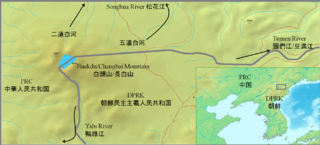
The Sino-Korean Border Agreement was signed by China and North Korea on October 12, 1962, in Pyongyang. This agreement and a subsequent agreement in 1964 define the modern border between the two countries. The agreement is widely viewed by both modern scholars and by contemporaries as being favorable to North Korea. As a result of the agreement, North Korea acquired 280 km2 of territory on and around Paektu Mountain, and 54.5% of the mountain's Heaven Lake. The previous practice of using the Yalu River and Tumen River for the rest of the border was affirmed.





















